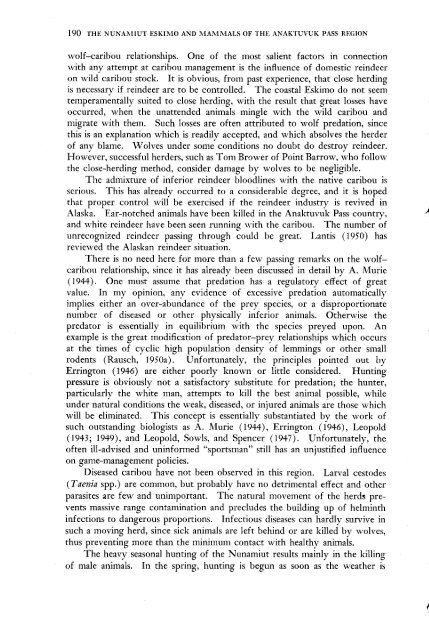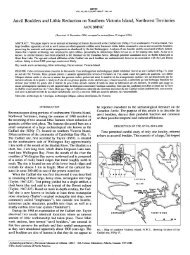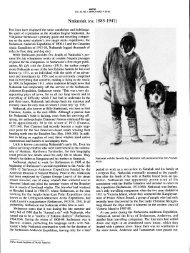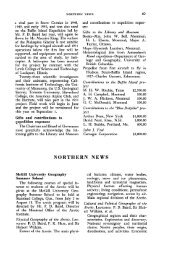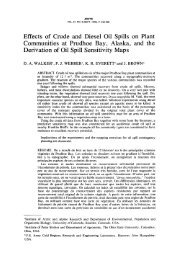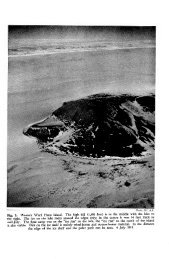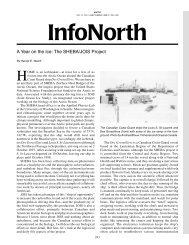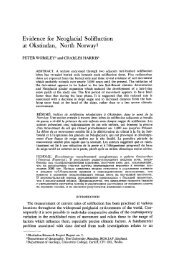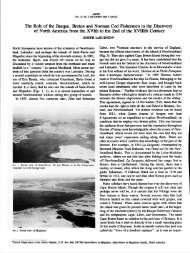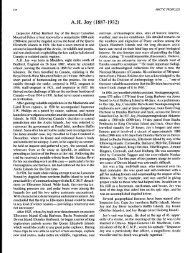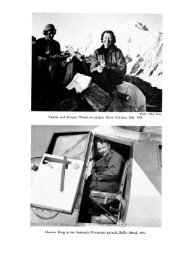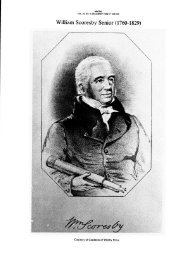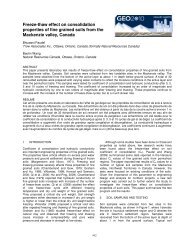NOTES ON THE NUNAMIUT ESKIMO AND MAMMALS OF ... - arctic
NOTES ON THE NUNAMIUT ESKIMO AND MAMMALS OF ... - arctic
NOTES ON THE NUNAMIUT ESKIMO AND MAMMALS OF ... - arctic
Create successful ePaper yourself
Turn your PDF publications into a flip-book with our unique Google optimized e-Paper software.
190 <strong>THE</strong> NUNARIIUT <strong>ESKIMO</strong> ArjD RIAMMALS <strong>OF</strong> ‘<strong>THE</strong> ANAKTUVUK P.4SS REGI<strong>ON</strong><br />
wolf-caribou relationships. One of the most salient factors in connection<br />
with any attempt at caribou management is the influence of domestic reindeer<br />
on wild caribou stock. It is obvious, from past experience, that close herding<br />
is necessary if reindeer are to be controlled. The coastal Eskimo do not seem<br />
temperamentally suited to close herding, with the result that great losses have<br />
occurred, when the unattended animals mingle with the wild caribou and<br />
migrate with them. Such losses are often attributed to wolf predation, since<br />
this is an explanation which is readily accepted, and which absolves the herder<br />
of any blame. Wolves under some conditions no doubt do destroy reindeer.<br />
However, successful herders, such as Tom Brower of Point Barrow, who follow<br />
the close-herding method, consider damage by wolves to be negligible.<br />
The admixture of inferior reindeer bloodlines with the native caribou is<br />
serious. This has already occurred to a considerable degree, and it is hoped<br />
that proper control will be exercised if the reindeer industry is revived in<br />
Alaska. Ear-notched animals have been killed in the Anaktuvuk Pass country,<br />
and white reindeer have been seen running with the caribou. The number of<br />
unrecognized reindeer passing through could be great. Lantis (1950)<br />
reviewed the Alaskan reindeer situation.<br />
has<br />
There is no need here for more than a few passing remarks on the wolfcaribou<br />
relationship, since it has already been discussed in detail by A. Ailurie<br />
(1944). One must assume that predation has a regulatory effect of great<br />
value. In my opinion, any evidence of excessive predation automatically<br />
implies either an over-abundance of the prey species, or a disproportionate<br />
number of diseased or other physically inferior animals. Otherwise the<br />
predator is essentially in equilibrium with the species preyed upon. An<br />
example is the great modification of predator-prey relationships which occurs<br />
at the times of cyclic high population density of lemmings or other small<br />
rodents (Rausch, 1950a). Unfortunately, the principles pointed out by<br />
Errington (1946) are either poorly known or little considered. Hunting<br />
pressure is obviously not a satisfactory substitute for predation; the hunter,<br />
particularly the white man, attempts to kill the best animal possible, while<br />
under natural conditions the weak, diseased, or injured animals are those which<br />
will be eliminated. This concept is essentially substantiated by the work of<br />
such outstanding biologists as A. Murie ( 1944), Errington (1946), Leopold<br />
(1943; 1949), and Leopold, Sowls, and Spencer (1947). Unfortunately, the<br />
often ill-advised and uninformed “sportsman” still has an unjustified influence<br />
on game-management policies.<br />
Diseased caribou have not been observed in this region. Larval cestodes<br />
(Taenia spp.) are common, but probably have no detrimental effect and other<br />
parasites are few and unimportant. The natural movement of the herds prevents<br />
massive range contamination and precludes the building up of helminth<br />
infections to dangerous proportions. Infectious diseases can hardly survive in<br />
such a moving herd, since sick animals are left behind or are killed by wolves,<br />
thus preventing more than the minimum contact with healthy animals.<br />
The heavy seasonal hunting of the Nunamiut results mainly in the killing<br />
of male animals. In the spring, hunting is begun as soon as the weather is


